David A. Riley's Blog, page 100
November 29, 2013
Jim Pitts Artwork
These are a few examples of the fantasy artist, Jim Pitts. The four black and white ones are originals, which illustrated some of my stories and were published in World of Horror magazine and the hard cover anthology Northern Chills. The colour work is an LP cover he did for Nick Caffrey's folk group, The Wassailers, in 1978.
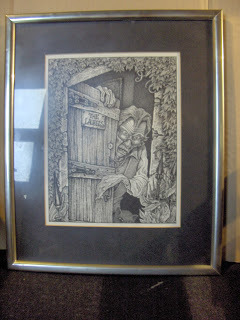 Northern Chills - illustrating Writer's Cramp
Northern Chills - illustrating Writer's Cramp
 World of Horror, illustrating The Shade of Apollyon
World of Horror, illustrating The Shade of Apollyon
 World of Horror, illustrating Terror on the Moors
World of Horror, illustrating Terror on the Moors
 Nick Carrfey's folk group The Wassailers, 1978
Nick Carrfey's folk group The Wassailers, 1978
 Northern Chills - illustrating Writer's Cramp
Northern Chills - illustrating Writer's Cramp World of Horror, illustrating The Shade of Apollyon
World of Horror, illustrating The Shade of Apollyon World of Horror, illustrating Terror on the Moors
World of Horror, illustrating Terror on the Moors Nick Carrfey's folk group The Wassailers, 1978
Nick Carrfey's folk group The Wassailers, 1978
Published on November 29, 2013 04:47
November 28, 2013
The Wyrd Sisters - Oswaldtwistle Players
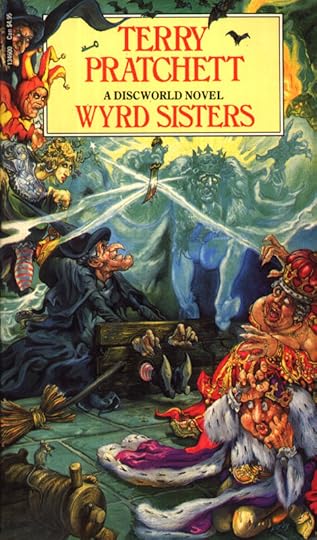 I'm looking forward to watching the Oswaldtwistle Players' next production, Stephen Briggs' adaptation of Terry Pratchett's Wyrd Sisters.
I'm looking forward to watching the Oswaldtwistle Players' next production, Stephen Briggs' adaptation of Terry Pratchett's Wyrd Sisters.This will be performed at the Civic Theatre, Union Road, Oswaldtwistle on April 30-3 May, 2014 at 7.30 p.m.
Published on November 28, 2013 01:37
November 26, 2013
Blood Bound Books Fourth Anniversary Sale

Blood Bound Books are having a Fourth Anniversary Sale on their ebooks, including copies of my novel The Return .
Check these out on Amazon.co.uk where it's available for £1.27 and Amazon.com where it's priced at $2.05.
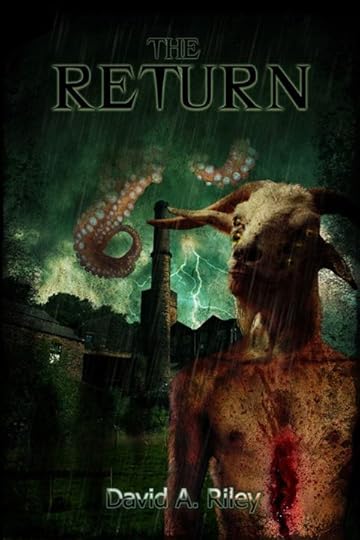
Published on November 26, 2013 01:23
November 25, 2013
Robert Aickman: A Centenary Tribute
 Cover and interior artwork
Cover and interior artworkJohnny Mains will be publishing Robert Aickman: A Centenary Tribute next year. Its contents will be:
Introduction by S.T. Joshi
Foreword by Johnny Mains
ESSAYS T.E.D. Klein - On Meeting Aickman
Lisa Tuttle - On Nearly Meeting Aickman
John L. Probert - The Adaptations
Hugh Lamb - Obituaries and Waterways
Jeremy Dyson - *untitled*
Roger Clarke - 'The Cicerones'
Reece Shearsmith - Reading Aickman
Philip Challinor- "Meeting Mr Millar" and "Letters from the Postman"
Richard Dalby - My friend, Robert Aickman
Sonia Rolt - Corrosion of a Friendship (about her husband L.T.C. Rolt)
David A. Riley - Robert Aickman Comes to Fantasycon
Douglas A. Anderson - The Film Reviewer
Johnny Mains - The Editor's Editor: Aickman and Fontana GhostsSTORIESOriginal Stories by:
Adam Nevill
Pete Crowther
Lynda E. Rucker
Simon Stranzas
Robert Shearman
Conrad Williams
Mark Morris
Stephen Volk
Reggie Oliver
Published on November 25, 2013 05:12
Tales of the Grotesque by L. A. Lewis

David Sutton has unveiled the cover art created by Dave Fletcher for Tales of the Grotesque by L. A. Lewis, due to be published by Shadow Publishing next year.
This was the cover for the first publication of this collection. A decent copy fetches high prices on the second hand book market.
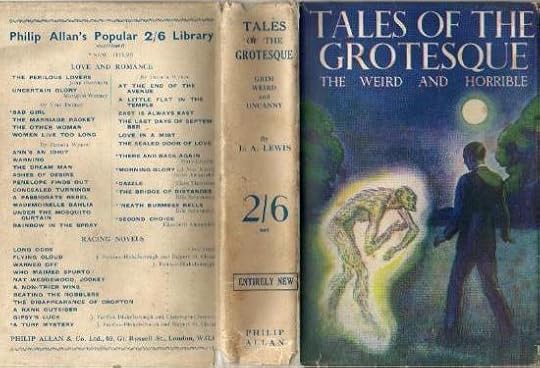
Published on November 25, 2013 03:23
November 23, 2013
Schalken the Painter
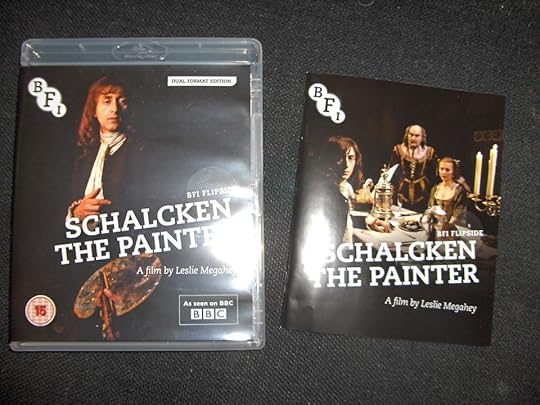 As a dual format edition from the BFI this came in both blu ray and DVD. Only having a DVD player, this was obviously the version I watched.
As a dual format edition from the BFI this came in both blu ray and DVD. Only having a DVD player, this was obviously the version I watched.What you get is Schalken the Painter, based on the Le Fanu story, broadcast by the BBC in 1979, two short films: The Pit (Edward Abraham, 1962, 27 mins) and The Pledge (Digby Rumsey, 1981, 21 mins), interviews with the director of Schalken, Leslie Megahey, and director of photography John Hooper on the making of the film (Look Into the Dark), some original production sketches for The Pit (which is based on the Poe story), and a fully illustrated and very informative booklet with essays by Ben Hervey, James Bell and Vic Pratt.
Obviously the main feature is Schalken the Painter, a gorgeously filmed adaptation of the Le Fanu story, narrated by Charles Grey, and starring Jeremy Clyde as Schalken, Maurice Denham as his mentor Dou, Cheryl Kennedy as Rose, Dou's ward, and John Justin as the sinister Vanderhausen. Leisurely paced, yet filled with details, this would have easily fit in the well respected Ghost Stories for Christmas based on the tales of M. R. James, if perhaps more akin to Jonathan Miller's Whistle and I'll Come to You, which like this was an Omnibus production.
If because of its source (the arts program Omnibus) there could be suspicions that the full horror of this story might have been diluted or made obscure, the final scenes dispel this completely and I think this was probably the most shocking ghost story I had ever seen on television when I first saw this in 1979. It has lost none of its impact now. Nor have the high production values in making it been exceeded either. This is a meticulously researched film with an impressive air of authenticity. Everything not only looks right, every beautifully designed scene could have come straight from a Dutch painting of the era in which it is based, from the sets, costumes and lighting.
No fan of Le Fanu will be disappointed by this rare adaptation of one of his stories.
The two short films accompanying it are not of the same class, but are interesting in their own right. My favourite of the two has to be The Pledge, a tale of three eighteenth century thieves who argumentatively decide to take down the rotting body of their friend, a highwayman captured, tried and executed and left hanging by the authorities in a gibbet on a lonely, windswept hill. The images of the body as it is glimpsed during the months it spends there, losing its feet to decay, are nightmarish and ugly. But there is a grotesque comic relief to all this when the three friends set out at the dead of night with a ladder to bury him in consecrated ground, even if it means dumping someone else's body elsewhere...
Published on November 23, 2013 02:35
November 22, 2013
An Adventure in Space and Time - the Start of the Doctor Who Story
 I can't claim to be a Whovian these days, though I probably was when the series first started in 1963, but I certainly enjoyed Mark Gatiss's dramatisation of the beginning of the series last night on the BBC. The recreation of the period looked spot on, and the performances of all those concerned really couldn't be faulted. I know that the end, when William Hartnell is compelled to bow out of the role, brought a tear to my wife's eyes. David Bradley gave a remarkable performance as the irascible Hartnell. I wish all TV dramas were as good as this.
I can't claim to be a Whovian these days, though I probably was when the series first started in 1963, but I certainly enjoyed Mark Gatiss's dramatisation of the beginning of the series last night on the BBC. The recreation of the period looked spot on, and the performances of all those concerned really couldn't be faulted. I know that the end, when William Hartnell is compelled to bow out of the role, brought a tear to my wife's eyes. David Bradley gave a remarkable performance as the irascible Hartnell. I wish all TV dramas were as good as this.
Published on November 22, 2013 02:30
Flowers of the Sea by Reggie Oliver
 I picked up Reggie Oliver's latest collection of stories from the Post Office this morning. I think I am probably one of the last people to get the book before it went out of print. I'm looking forward to dipping into this over the next few days. What with getting the DVD of Schalken the Painter in the post yesterday, and not this, things are getting off to a good start for the weekend.
I picked up Reggie Oliver's latest collection of stories from the Post Office this morning. I think I am probably one of the last people to get the book before it went out of print. I'm looking forward to dipping into this over the next few days. What with getting the DVD of Schalken the Painter in the post yesterday, and not this, things are getting off to a good start for the weekend.
Published on November 22, 2013 02:27
November 20, 2013
R'ha - an incredible 6-minute film created by a film design student
Kokatu.com posted an amazing short film called R'ha created by a 22 year old digital film design student called Kaleb Lechowski who, apart from the voices (by David Masterson) did everything himself. This is an incredible piece of work and I'm sure we'll all hear a lot more about him in the future.
Published on November 20, 2013 01:52
Whispers from the Abyss - Book Review
 WHISPERS FROM THE ABYSSA collection of H. P. Lovecraft inspired short fictionEdited by Kat RochaCover by Josh Finney01 Publishingebook
WHISPERS FROM THE ABYSSA collection of H. P. Lovecraft inspired short fictionEdited by Kat RochaCover by Josh Finney01 PublishingebookLovecraft has never been more popular, and there seem to be more books inspired by his tales out today than ever before. This anthology, edited by Kat Rocha, contains 33 stories by many writers unknown to me, but a few I am familiar with, like Nick Mamatas, Charles Black, and Aaron J. French.
My first fear was that with so many stories there would be a repetition of theme and style, but that was quickly dispelled. Though most are quite short, they are refreshingly wide ranging. If there is a frequent theme it may be the use of Lovecraft’s Deep Ones, but even here the approach to this trope is broad. Jason Andrew’s “Fear And Loathing In Innsmouth: Richard Nixon’s Revenge” is perhaps the most original. Written as if by Hunter S. Thompson, it follows the Gonzo journalist during the presidential election towards Innsmouth and the source of Nixon’s campaign money. Visiting the Arkham Asylum the narrator has this to say about one of the residents. “He had thick jowls, bulbous eyes, and a suspiciously Nixon-like jump nose. I made certain that he was always two steps ahead of me and always in my line of sight.” A great story, totally in keeping with the character of its narrator.
Charles Black contributes two stories, one of which must be a contender for the shortest horror story ever written. Called “The Last Tweet” it is exactly what it says, a tweet. Incredibly Black manages to encapsulate an entire short story into 19 words, and even manages to use an old cliché of many bad Lovecraftian pastiches – which for once makes sense and works. About this I am saying no more. Read it for yourself. It won’t take you long.
Nick Mamatas’s “Hideous Interview With Brief Man” is a bizarre interrogation, whose true horror only materialises in the final few sentences.
“My Stalk” by Aaron J. French turns for inspiration towards Lovecraft’s fantasy writings, though written in its own style, which is both fluid and almost hypnotic.
There are too many stories to highlight more than a few, but I failed to find any that was not well written and distinctively individual. If I had one complaint it could be the preponderance of first person narratives, but that may be because I have a preference for the third person singular. Not a serious defect, and one which most readers may not even notice, especially if they tend to dip in and out of anthologies.
The book has a gorgeous cover by Josh Finney, whose beauty I would love to see in print one day rather than almost lost on my Kindle in black and white.
A great, engrossing and varied anthology of Lovecraftian fiction, I would recommend it to anyone who likes this type of story.
TABLE OF CONTENTS
Introduction by Alasdair Stuart
“Iden-Inshi” by Greg Stolze
“Pushing Back” by J.C. Hemphill
“Nation of Disease: The Rise & Fall of a Canadian Legend” by Jonathan Sharp
“When We Change” by Mason Ian Bundschuh
“Nutmeat” by Martin Hill Ortiz
“The Last Tweet” by Charles Black
“Secrets In Storage” by Tim Pratt & Greg Van Eekhout
“The Well” by Tim Jeffreys
“The Neon Morgue” by Nathan Wunner
“The Deep” by Corissa Baker
“Fear And Loathing In Innsmouth: Richard Nixon’s Revenge” by Jason Andrew
“My Friend Fishfinger By Daisy, Age 7″ by David Tallerman
“Chasing Sunset” by A.C. Wise
“The Thing With Onyx Eyes” by Stephen Brown
“I Do The Work Of The Bone Queen” by John R. Fultz
“Suck It Up, Get It Done” by Brandon Barrows
“The Substance In The Sound” by W.B. Stickel
“Stone City, Old As Immeasurable Time” by Kelda Crich
“Hideous Interview With Brief Man” by Nick Mamatas
“The Sea, Like Glass Unbroken” by Silvia Moreno-Garcia
“The Decorative Water Feature Of Nameless Dread” by James Brogden
“Henry” by Lance Axt
“My Stalk” by Aaron J. French
“Give Me That Old Time Religion” by Lee Finney
“Afraid Of Dobermans” by Chad Fifer
“Leviathan” by Nicholas Almand
“Horrorscope” by Charles Black
“The Jar Of Aten-Hor” by Kat Rocha
“The Floor” by Jeff Provine
“Waiting” by Dennis Detwiller
“Other People’s Houses” by Sarena Ulibarri
“You Will Never Be The Same” by Erica Satifka
“Death Wore Greasepaint” by Josh Finney
Published on November 20, 2013 00:54



